Transit – 100 course points
The purpose of this assignment is to practice your understanding of linked structures.
Start your assignment early! This assignment is substantially harder than the previous assignment. You need time to understand the assignment and to answer the many questions that will arise as you read the description and the code provided.
Refer to our Programming Assignments FAQ for instructions on how to install VSCode, how to use the command line and how to submit your assignments.
Overview
You’ve just moved into a new city, and you’re planning your daily commute. You have 3 modes of public transportation available to you: the subway, the bus, and of course you can just walk. You can imagine locations in the city as a number line which increments from your starting location of 0 (zero). You can only move forward along this number line in your journey. The train is much faster than the bus, and the bus is much faster than walking. Unfortunately, the train can only stop at points where a train station exists, and the bus can only stop at points where a bus stop exists. You may assume that a bus stop exists at every train station, and that you may begin walking from any bus stop. You may walk forward and end your walking journey at any point.
The Linked Structure

You figured out that you can visualize your journey using a special 3 layered linked list, see the diagram above.
- The top layer represents the train, the middle layer represents the bus, and the bottom layer represents walking.
- Each node in your layered linked list contains an integer representing the location, a reference next representing the next location you can visit in your current mode of transport, and a reference down which takes you down to the SAME location in a slower mode of transport.
- For example, in the diagram above, the node 4 in the train layer points to node 4 in the bus layer, which points to node 4 in the walking layer.
- next will be set to null if there are no more locations to visit on the current mode of transport, and down will be set to null if you are in the walking layer.
Implementation
Overview of files provided
- TNode class, which houses an int for location, and next and down pointers. Getters and setters are provided. Do not edit this class. It is not submitted, but it is used exactly as written to grade your code.
- Driver class, which you can run to test any of your methods interactively. Feel free to edit this class, as it is provided only to help you test. It is not submitted and it is not used to grade your code.
- StdIn and StdOut, which are used by the driver. Do not edit these classes..
- Transit class, that course trainZero, a reference to the zero node in the train layer. It also contains the methods that you are expected to fill in, followed by methods which are used by the driver. Edit the empty methods with you solution, but DO NOT edit the provided ones. This is the file you submit.
- Multiple text files which contain input data, and can be read by the driver as test cases. Feel free to edit them or even make new ones to help test your code. They are not submitted.
Transit.java
NOTE: You are allowed (encouraged, even) to make helper methods in your Transit.java file to be used in your graded methods. Just make sure that they are created with the private keyword. Do not add new imports.
Methods to be implemented by you:
1. makeList (write this method first)
- This method builds your layered linked list structure. It takes in sorted integer arrays representing train stations, bus stops, and walking locations.
- It is guaranteed that the bus array contains all values in the train array, and the walking array contains all values in the bus array. It is also guaranteed that the walking array contains every integer from 1 to its largest value.
- Every layer of your list should start with a node at location 0 (zero), and by following the next pointers, you should visit each value in the corresponding array. Note that 0 (zero) will NOT be present in the input arrays, and you are responsible for adding zero nodes for each layer yourself. Additionally, the nodes in the train layer should point down to the node in the bus layer of the same location, and the nodes in the bus layer should point down to the nodes in the walking layer of the same location.
- Set trainZero to the zero node of the train layer (the topmost layer). Nothing should be returned.
- You have been provided some input files to test this method (input1.txt, input2.txt, input3.txt). The format is as follows:
- One line containing the number of train stations
- One line containing the location of each train station, space separated
- One line containing the number of bus stops
- One line containing the location of each bus stop, space separated
- One line containing the number of walking locations
- One line containing each walking location, space separated
Below is an example of running the driver to help test this method.
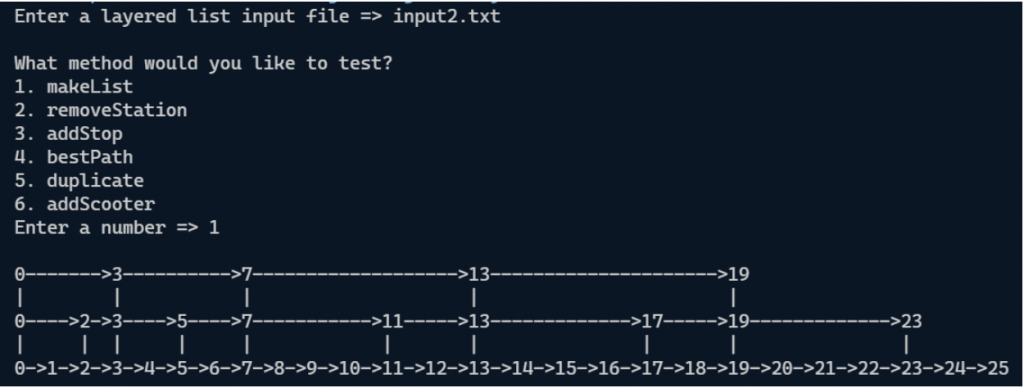
2. removeTrainStation
- Given an integer representing the location of a train station, write a method to remove the given train station from the layered linked list.
- Note that the corresponding bus stop and walking location are NOT to be removed.
- Perform your operations on the layered linked list referenced by the trainZero without returning anything.
- If the specified train station doesn’t exist, do nothing. The specified train stations used for grading are guaranteed to not be the zero node.
- The input files to test this method are the same as makeList.
Below is an example of running the driver to help test this method.
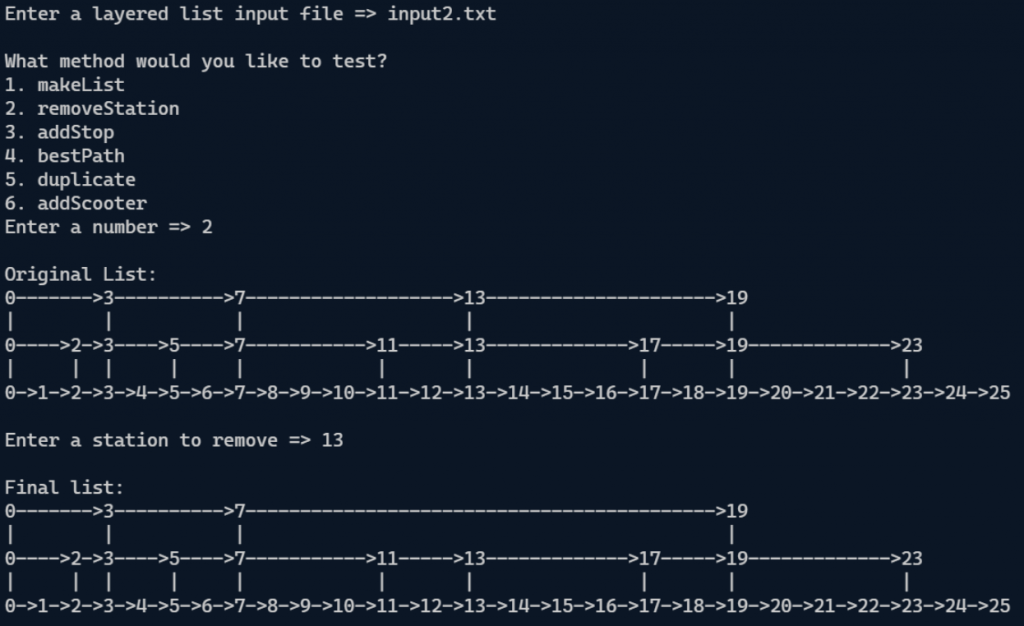
3. addBusStop
- Given an integer representing the location of a new bus stop, write a method to add the new bus stop to the layered linked list.
- The bus stops used for grading are guaranteed to correspond to a walking layer node.
- If the specified bus stop already exists, do nothing.
- Perform your operations on the layered lined list referred by trainZero without returning anything.
- The input files to test this method are the same as makeList.
Below is an example of running the driver to help test this method.
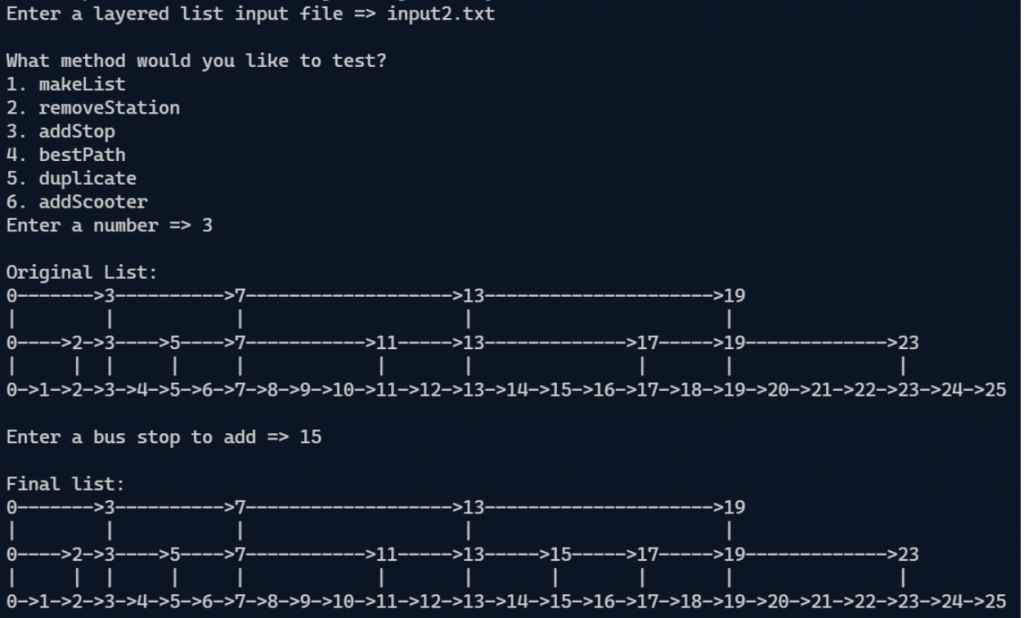
4. bestPath
- Given an integer representing the destination location, determine the optimal path to get there.
- Remember that you can only move forward or down through your layered list, and that you don’t want to overshoot your destination in either the train or bus layers.
- You want to stay on the train as long as you possibly can, then you want to stay on the bus as long as you possibly can, before walking to your destination.
- Add every TNode along the best path to an ArrayList, ending in the destination node in the walking layer, returning this arraylist.
- The input files to test this method are the same as makeList
Below is an example of running the driver to help test this method:
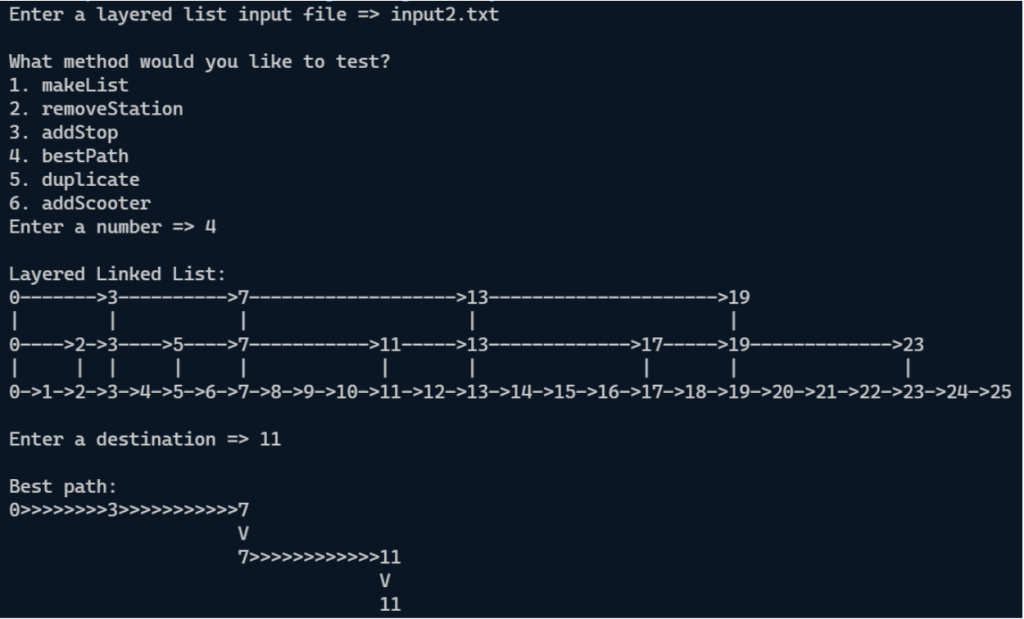
5. duplicate
- Write this method to return a deep copy of the layered linked list referred by trainZero.
- This means that the structure of the new list should be exactly the same, with the same values and connections in the train, bus, and walking layers.
- It should be able to function exactly as the original list does. However, there should be NO nodes present in the copy which also exist in the original. In order for your deep copy to be graded as correct, every single node in it must have been created using the new keyword. Return the zero node in the train layer of the deep copy.
- The input files to test this method are the same as makeList.
Below is an example of running the driver to help test this method:
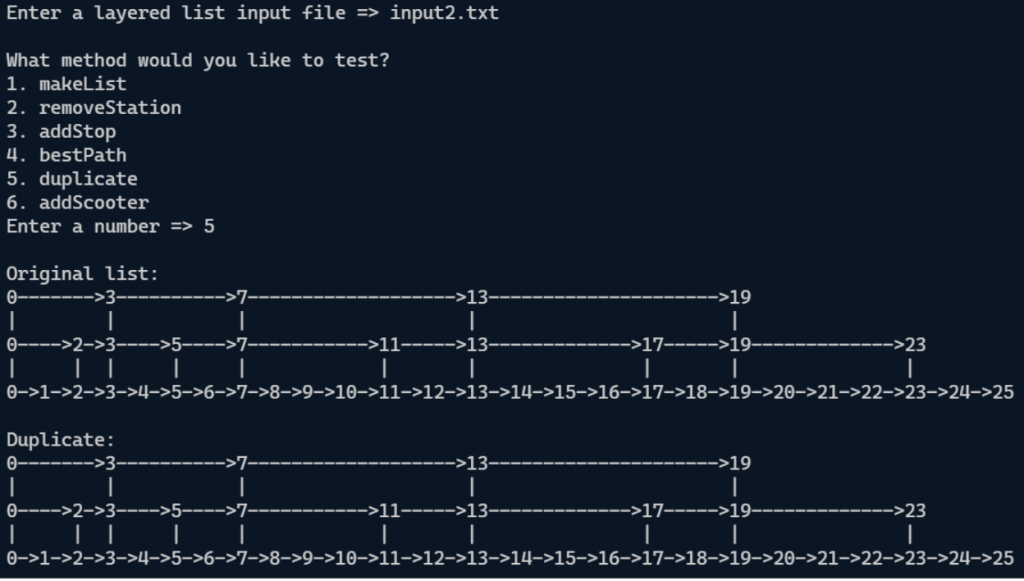
6. addScooter
Your city has FINALLY added those new electric scooters (you may have even seen them around the Rutgers campus)!
- You can’t wait to try them, and you decide to try to add them to your daily commute.
- You notice that the scooters can be picked up at any bus station and can be dropped off in slightly more locations, though they still can’t get you to as many places as walking.
- Naturally, you decide to implement this change to your commute as a “scooter layer” underneath the bus layer but above the walking layer.
- Write a method which takes in a sorted integer array representing the locations in the scooter layer. Then update the layered linked list so that the bus layer points down to the correct nodes in the new scooter layer, and the new scooter layer points down to the correct nodes in the walking layer.
- Perform your operations on the layered list without returning anything.
- You have been provided some input files to help test this method (scooter2.txt, scooter3.txt). The scooter2 file should only be used with input2.txt, and the scooter3 file should only be used with input3.txt. The format is as follows:
- One line containing the number of scooter stops
- One line containing all the locations of scooter stops, space separated
Below is an example of running the driver to help test this method:

Implementation Notes
- YOU MAY only update the methods makeList(), removeTrainStation(), addBusStop(), addScooter(), bestPath(), and duplicate().
- DO NOT add any instance variables to the Transit class.
- DO NOT add any public methods to the Transit class.
- YOU MAY add private methods to the Transit class.
- DO NOT use System.exit()
VSCode Extensions
You can install VSCode extension packs for Java. Take a look at this tutorial. We suggest:
Importing VSCode Project
- Download Transit.zip from Autolab Attachments.
- Unzip the file by double clicking.
- Open VSCode
- Same process you did for the previous assignment
- Import the folder to a workspace through File > Open
Executing and Debugging
- You can run your program through VSCode or you can use the Terminal to compile and execute. We suggest running through VSCode because it will give you the option to debug.
- How to debug your code
- If you choose the Terminal:
- first navigate to Transit directory/folder
- to compile: javac -d bin src/transit/*.java
- to execute: java -cp bin transit.Driver
- first navigate to Transit directory/folder
Before submission
Collaboration policy. Read our collaboration policy here.
Submitting the assignment. Submit Transit.java separately via the web submission system called Autolab. To do this, click the Assignments link from the course website; click the Submit link for that assignment.
Getting help
If anything is unclear, don’t hesitate to drop by office hours or post a question on Piazza. Find instructors office hours by clicking the Staff link from the course website. In addition to office hours we have the CAVE (Collaborative Academic Versatile Environment), a community space staffed with lab assistants which are undergraduate students further along the CS major to answer questions.
Problem by Ishaan Ivaturi

